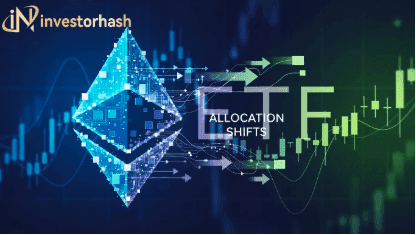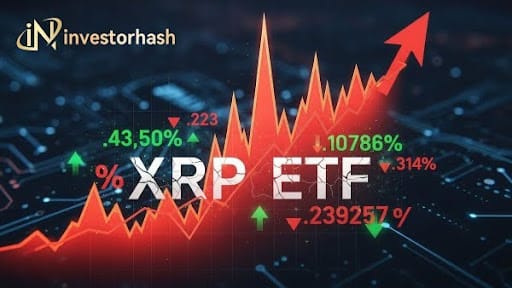MARA Holdings Reports Record 35 Percent Bitcoin Production Increase Despite Rising Network Difficulty

MARA Holdings achieved record Bitcoin production in May 2025, mining 950 BTC and earning 282 blocks, representing a 35% month-over-month production increase. Cointelegraph reported that the publicly traded mining company posted a 38% increase in blocks earned compared to April, establishing new monthly highs despite escalating network difficulty. The company now holds 49,179 BTC worth approximately $5.2 billion, with Chief Financial Officer Salman Khan confirming zero Bitcoin sales during May.
Rising Network Difficulty Creates Industry Challenges
Bitcoin mining faces unprecedented difficulty levels as the network hashrate reached record highs. CoinDesk reports Bitcoin mining difficulty surged past 126 trillion on May 30, marking a new all-time high. The seven-day average hashrate climbed to 918 exahashes per second from 840 EH/s within two weeks. These developments create operational pressures for miners seeking profitability.
Global mining competition intensified throughout 2025. Cointelegraph analysis shows hashprice dropped from $0.12 in April 2024 to approximately $0.049 by April 2025. Network difficulty reached 123 trillion, making revenue generation more complex for mining operations. Energy costs now dictate profitability margins across the industry.
Mining companies invest heavily in efficiency improvements. MARA completed installation of 12,000 Bitmain S21 Pro miners at its Ohio facility while achieving full energization of low-cost gas-powered operations. The company expanded its Ohio data center to 100 megawatts, with plans to scale to 200 megawatts. These infrastructure investments help maintain competitive advantages amid rising operational complexity.
MARA's Strategic Infrastructure Expansion
MARA's proprietary mining pool delivers performance advantages over industry standards. The company operates MARAPool, the only self-owned mining pool among publicly traded miners. This infrastructure eliminates external operator fees while providing superior control and efficiency. Pool performance exceeded network averages by over 10% since launch.
Infrastructure expansion drives production gains across multiple facilities. MARA's energized hashrate grew 5.5% to 57.3 EH/s in April before the May production surge. The company completed a 50-megawatt expansion at its Ohio facility, bringing total operational capacity to 100 megawatts. Gas-to-power operations in North Dakota provide low-cost energy sources for mining operations.
Financial metrics demonstrate operational excellence. Coin Push reports MARA maintains strong liquidity with a current ratio of 4.94, positioning the company to weather market downturns. The firm's market capitalization reached $5 billion with 69% revenue growth over the past year. Bitcoin holdings increased 175% year-over-year from previous levels.
Institutional Investment and Market Outlook
Bitcoin institutional adoption accelerates throughout 2025, creating favorable market conditions. Security.org research shows 60% of Americans familiar with cryptocurrency believe values will rise due to recent political developments. Industry experts project Bitcoin prices could reach $150,000 to $185,000 in 2025, with some analysts targeting $200,000.
ETF inflows continue driving institutional participation. Coinbase analysis indicates spot Bitcoin ETFs attracted significant institutional fund inflows, establishing Bitcoin as a mainstream asset. Traditional financial institutions increase Bitcoin allocations through regulated investment vehicles. Insurance companies and pension funds explore pilot programs for digital asset exposure.
Mining industry diversification trends emerge across the sector. ChainUp reports mining companies transition from exclusive cryptocurrency mining to general-purpose data centers serving high-performance computing and artificial intelligence applications. This strategic pivot allows miners to leverage existing infrastructure while accessing new revenue streams beyond Bitcoin mining.
Broader Cryptocurrency Market Implications
Mining infrastructure improvements strengthen Bitcoin network security. Rising hashrate levels provide enhanced blockchain protection against potential attacks. The computational power dedicated to network maintenance reaches record levels, demonstrating long-term confidence in Bitcoin's value proposition. Network difficulty adjustments ensure consistent block production times despite hashrate fluctuations.
Global mining distribution continues evolving following regulatory changes. Hashrate Index reports the United States maintains its position as the leading Bitcoin mining market, offering institutional involvement and favorable risk-adjusted returns. Other countries like Canada, Russia, and Paraguay compete for mining operations through energy cost advantages and regulatory frameworks.
Energy efficiency becomes paramount for mining profitability. Latest ASIC models from manufacturers optimize energy consumption per hash, with equipment delivering improved performance ratios. Miners pursuing sustainability initiatives gain competitive advantages through renewable energy integration. These developments address environmental concerns while maintaining operational viability.
MARA's record performance demonstrates the mining industry's resilience amid challenging market conditions. Companies with strategic infrastructure investments, efficient operations, and strong balance sheets position themselves for continued growth. The intersection of institutional adoption, technological advancement, and regulatory clarity creates opportunities for industry leaders to expand their market presence throughout 2025.
Related Reading on BTC Peers
For deeper insights into global Bitcoin policy developments, read this analysis at BTC Peers Global Bitcoin Policy Index. This comprehensive resource examines regulatory frameworks across different jurisdictions, providing readers with essential information about how government policies affect Bitcoin adoption and mining operations worldwide. The analysis covers policy trends that directly impact institutional investment decisions and mining industry development strategies.




